Synergizing Virtual Screening and Zebrafish Models to Identify Resveratrol-Derived Antiaging Polyphenols
Abstract
1. Introduction
2. Results
2.1. In Silico Analysis for the Selection of the Top Ten Resveratrol-Derived Molecules
2.2. In Silico Screening Predicts the Interaction Between Selected Resveratrol Derivatives and the Catalytic Subunit of Telomerase, TERT
2.3. Resveratrol and Sakuranetin Improve Telomeric Health, with Resveratrol Further Enhancing ST2 Larval Longevity
2.4. Apigenin, Genistein and Hesperetin Show Both Anti-Inflammatory and Antioxidant Properties
3. Discussion
4. Materials and Methods
4.1. Molecule File Preparation
4.2. Ligand Database
4.3. Ligand-Based Virtual Screening (LBVS)
4.4. Animals
4.5. Drug Treatment
4.6. Gene Expression Analysis
4.7. Telomerase Activity Assay
4.8. Telomere Length Measurement
4.9. Survival Analysis
4.10. Imaging of Zebrafish Larvae
4.11. Neutrophil Counts
4.12. Reactive Oxygen Species (ROS) Staining
4.13. Acridine Orange (AO) Staining Assay
4.14. Statistical Analysis
5. Conclusions
Supplementary Materials
Author Contributions
Funding
Institutional Review Board Statement
Informed Consent Statement
Data Availability Statement
Acknowledgments
Conflicts of Interest
Abbreviations
| AD | AutoDock 4 |
| AK | AutoDock Vina |
| AMPK | AMP-activated protein kinase |
| AO | Acridine Orange |
| AR | Aromatic Ring |
| CHAPS | 3-[(3-Cholamidopropyl)dimethylammonio]-1-propanesulfonate |
| dpf | days post-fertilization |
| cDNA | complementary DNA |
| gDNA | genomic DNA |
| H | Hydrophobic moiety |
| HBA | Hydrogen Bond Acceptor |
| HBD | Hydrogen Bond Donor |
| hpf | hours post-fertilization |
| LBVS | Ligand-Based Virtual Screening |
| LF | LeadFinder |
| mRNA | messenger RNA |
| MW | Molecular Weight |
| PDB | Protein Data Bank |
| qPCR | quantitative Polymerase Chain Reaction |
| qTRAP | quantitative Telomerase Repeated Amplification Protocol |
| ROI | Region Of Interest |
| ROS | Reactive Oxygen Species |
| rps11 | ribosomal protein S11 encoding zebrafish gene |
| RTA | Relative Telomerase Activity |
| SD | Standard Deviation |
| SIRT1 | Sirtuin 1 |
| ST2 | Short Telomere 2nd round |
| tert | telomerase reverse transcriptase encoding zebrafish gene |
| Tert | Telomerase reverse transcriptase, zebrafish protein |
| TERT | TElomerase Reverse Transcriptase, human protein |
| TPSA | Topological Polar Surface Area |
| VS | Virtual Screening |
| ZFIN | ZebraFish Information Network |
| 2D | Two-dimensional |
| 3D | Three-dimensional |
Appendix A
| Docking | AD | AD | AD | AD | AD | AD | AD | AD | AD |
| Candidates | Apigenin | Genistein | Hesperetin | Liquiritigenin | Naringenin | Quercetin | Resveratrol | Sakuranetin | Tricetin |
| 414 Arg | X | X | X | X | X | X | X | X | X |
| 419 Leu | X | X | X | X | X | X | X | X | |
| 480 Ala | X | X | |||||||
| 592 Arg | X | X | X | X | X | X | X | X | |
| 76 Lys | X | X | X | X | X | X | |||
| 84 Glu | X | X | X | X | X | ||||
| 483 Met | X | X | |||||||
| 547 Arg | X | ||||||||
| 593 Lys | X | X | |||||||
| Cluster | 3 | 2 | 2 | 1 | 3 | 2 | 3 | 2 | 2 |
| Energy | −7.76 | −7.73 | −8.92 | −8.29 | −7.69 | −9.12 | −6.81 | −7.59 | −7.85 |
| Name | Sequence 5′→3′ | Application |
| tert-Fw | CGGTATGACGGCCTATCACT | gene expression |
| tert-Rv | TAAACGGCCTCCACAGAGTT | gene expression |
| ACX | GCGCGGCTTACCCTTACCCTTACCCTAACC | telomerase activity |
| TS | AATCCGTCGAGCAGAGTT | telomerase activity |
| telom-Fw | GGTTTTTGAGGGTGAGGGTGAGGGTGAGGGTGAGGGT | telomere content |
| telom-Rv | TCCCGAACTATCCCTATCCCTATCCCTATCCCTATCCCTA | telomere content |
| rps11-Fw | ACAGAAATGCCCCTTCACTG | gene expresión telomere content |
| rps11-Rv | GCCTCTTCTCAAAACGGTTG | gene expresión telomere content |

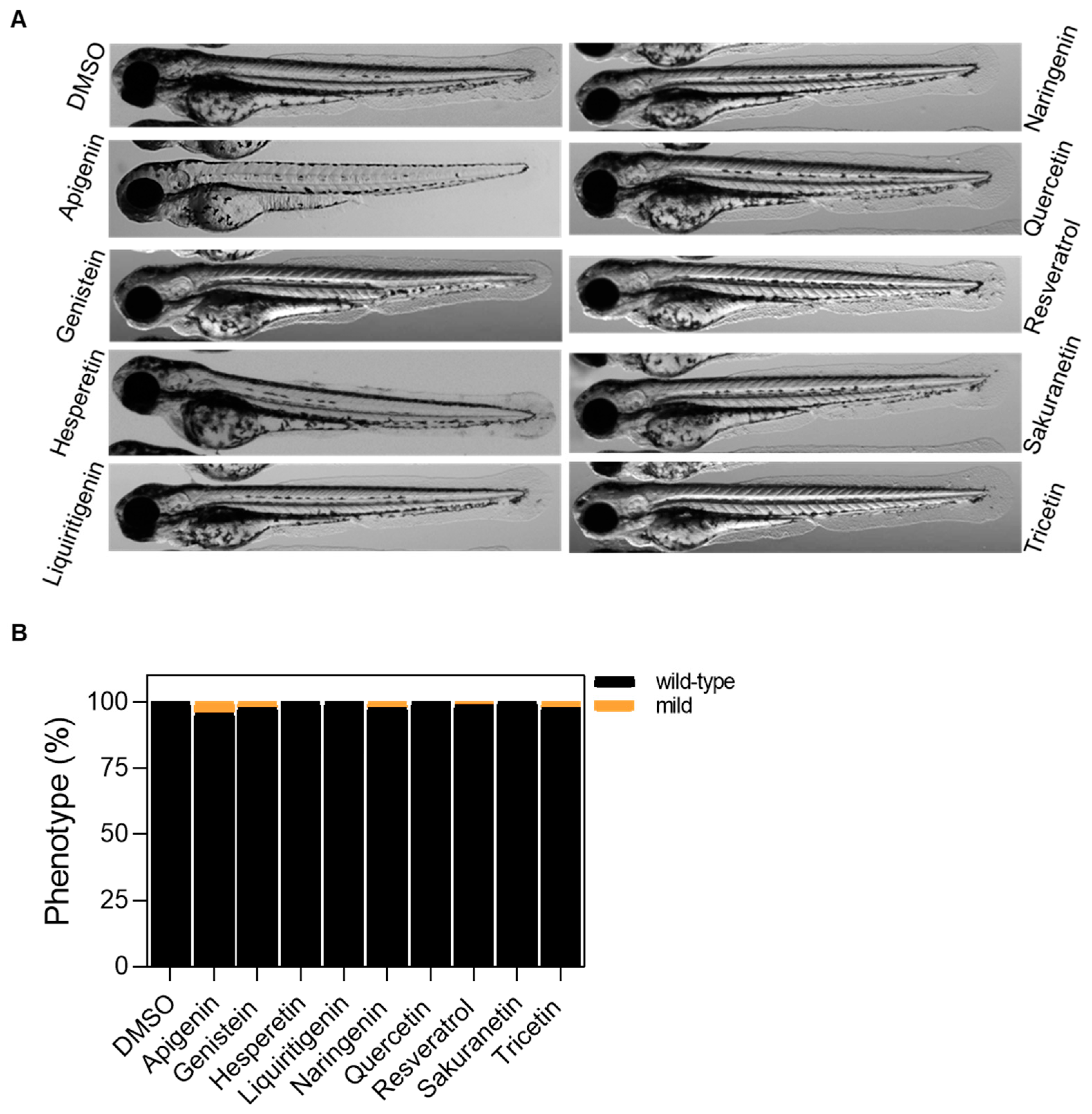
References
- Rodriguez-Rodero, S.; Fernandez-Morera, J.L.; Menendez-Torre, E.; Calvanese, V.; Fernandez, A.F.; Fraga, M.F. Aging genetics and aging. Aging Dis. 2011, 2, 186–195. [Google Scholar] [PubMed]
- Lopez-Otin, C.; Blasco, M.A.; Partridge, L.; Serrano, M.; Kroemer, G. The hallmarks of aging. Cell 2013, 153, 1194–1217. [Google Scholar] [CrossRef] [PubMed]
- Blasco, M.A. Telomeres and human disease: Ageing, cancer and beyond. Nature reviews. Genetics 2005, 6, 611–622. [Google Scholar] [CrossRef] [PubMed]
- Pawelec, G. Hallmarks of human “immunosenescence”: Adaptation or dysregulation? Immun. Ageing 2012, 9, 15. [Google Scholar] [CrossRef]
- Goronzy, J.J.; Fang, F.; Cavanagh, M.M.; Qi, Q.; Weyand, C.M. Naive T cell maintenance and function in human aging. J. Immunol. 2015, 194, 4073–4080. [Google Scholar] [CrossRef]
- Wherry, E.J.; Kurachi, M. Molecular and cellular insights into T cell exhaustion. Nat. Rev. Immunol. 2015, 15, 486–499. [Google Scholar] [CrossRef]
- Franceschi, C.; Bonafe, M.; Valensin, S.; Olivieri, F.; De Luca, M.; Ottaviani, E.; De Benedictis, G. Inflamm-aging. An evolutionary perspective on immunosenescence. Ann. N. Y. Acad. Sci. 2000, 908, 244–254. [Google Scholar] [CrossRef]
- Vazquez, J.; Lopez, M.; Gibert, E.; Herrero, E.; Luque, F.J. Merging Ligand-Based and Structure-Based Methods in Drug Discovery: An Overview of Combined Virtual Screening Approaches. Molecules 2020, 25, 4723. [Google Scholar] [CrossRef]
- Lavecchia, A.; Di Giovanni, C. Virtual screening strategies in drug discovery: A critical review. Curr. Med. Chem. 2013, 20, 2839–2860. [Google Scholar] [CrossRef]
- Zon, L.I.; Peterson, R.T. In vivo drug discovery in the zebrafish. Nature reviews. Drug Discov. 2005, 4, 35–44. [Google Scholar] [CrossRef]
- Patton, E.E.; Zon, L.I.; Langenau, D.M. Zebrafish disease models in drug discovery: From preclinical modelling to clinical trials. Nature reviews. Drug Discov. 2021, 20, 611–628. [Google Scholar] [CrossRef] [PubMed]
- Hernandez-Silva, D.; Alcaraz-Perez, F.; Perez-Sanchez, H.; Cayuela, M.L. Virtual screening and zebrafish models in tandem, for drug discovery and development. Expert Opin. Drug Discov. 2023, 18, 903–915. [Google Scholar] [CrossRef] [PubMed]
- Cayuela, M.L.; Claes, K.B.M.; Ferreira, M.G.; Henriques, C.M.; van Eeden, F.; Varga, M.; Vierstraete, J.; Mione, M.C. The Zebrafish as an Emerging Model to Study DNA Damage in Aging, Cancer and Other Diseases. Front. Cell Dev. Biol. 2018, 6, 178. [Google Scholar] [CrossRef] [PubMed]
- Carneiro, M.C.; de Castro, I.P.; Ferreira, M.G. Telomeres in aging and disease: Lessons from zebrafish. Dis. Models Mech. 2016, 9, 737–748. [Google Scholar] [CrossRef]
- Hernandez-Silva, D.; Lopez-Abellan, M.D.; Martinez-Navarro, F.J.; Garcia-Castillo, J.; Cayuela, M.L.; Alcaraz-Perez, F. Development of a Short Telomere Zebrafish Model for Accelerated Aging Research and Antiaging Drug Screening. Aging Cell 2025, 24, e70007. [Google Scholar] [CrossRef]
- Carney, T.J.; von der Hardt, S.; Sonntag, C.; Amsterdam, A.; Topczewski, J.; Hopkins, N.; Hammerschmidt, M. Inactivation of serine protease Matriptase1a by its inhibitor Hai1 is required for epithelial integrity of the zebrafish epidermis. Development 2007, 134, 3461–3471. [Google Scholar] [CrossRef]
- Mathias, J.R.; Dodd, M.E.; Walters, K.B.; Rhodes, J.; Kanki, J.P.; Look, A.T.; Huttenlocher, A. Live imaging of chronic inflammation caused by mutation of zebrafish Hai1. J. Cell Sci. 2007, 120, 3372–3383. [Google Scholar] [CrossRef]
- Galiniak, S.; Aebisher, D.; Bartusik-Aebisher, D. Health benefits of resveratrol administration. Acta Biochim. Pol. 2019, 66, 13–21. [Google Scholar] [CrossRef]
- Zhang, P.; Li, Y.; Du, Y.; Li, G.; Wang, L.; Zhou, F. Resveratrol Ameliorated Vascular Calcification by Regulating Sirt-1 and Nrf2. Transpl. Proc. 2016, 48, 3378–3386. [Google Scholar] [CrossRef]
- Cao, W.; Dou, Y.; Li, A. Resveratrol Boosts Cognitive Function by Targeting SIRT1. Neurochem. Res. 2018, 43, 1705–1713. [Google Scholar] [CrossRef]
- Price, N.L.; Gomes, A.P.; Ling, A.J.; Duarte, F.V.; Martin-Montalvo, A.; North, B.J.; Agarwal, B.; Ye, L.; Ramadori, G.; Teodoro, J.S.; et al. SIRT1 is required for AMPK activation and the beneficial effects of resveratrol on mitochondrial function. Cell Metab. 2012, 15, 675–690. [Google Scholar] [CrossRef]
- Gutlapalli, S.D.; Kondapaneni, V.; Toulassi, I.A.; Poudel, S.; Zeb, M.; Choudhari, J.; Cancarevic, I. The Effects of Resveratrol on Telomeres and Post Myocardial Infarction Remodeling. Cureus 2020, 12, e11482. [Google Scholar] [CrossRef] [PubMed]
- Park, D.W.; Kim, J.S.; Chin, B.R.; Baek, S.H. Resveratrol inhibits inflammation induced by heat-killed Listeria monocytogenes. J. Med. Food 2012, 15, 788–794. [Google Scholar] [CrossRef] [PubMed]
- Xia, N.; Daiber, A.; Forstermann, U.; Li, H. Antioxidant effects of resveratrol in the cardiovascular system. Br. J. Pharmacol. 2017, 174, 1633–1646. [Google Scholar] [CrossRef] [PubMed]
- Sawda, C.; Moussa, C.; Turner, R.S. Resveratrol for Alzheimer’s disease. Ann. N. Y. Acad. Sci. 2017, 1403, 142–149. [Google Scholar] [CrossRef]
- Smoliga, J.M.; Blanchard, O. Enhancing the delivery of resveratrol in humans: If low bioavailability is the problem, what is the solution? Molecules 2014, 19, 17154–17172. [Google Scholar] [CrossRef]
- Xiao, Z.P.; Lv, T.; Hou, P.P.; Manaenko, A.; Liu, Y.; Jin, Y.; Gao, L.; Jia, F.; Tian, Y.; Li, P.; et al. Sirtuin 5-Mediated Lysine Desuccinylation Protects Mitochondrial Metabolism Following Subarachnoid Hemorrhage in Mice. Stroke 2021, 52, 4043–4053. [Google Scholar] [CrossRef]
- Gertz, M.; Steegborn, C. Function and regulation of the mitochondrial sirtuin isoform Sirt5 in Mammalia. Biochim. Biophys. Acta 2010, 1804, 1658–1665. [Google Scholar] [CrossRef]
- Kennedy, B.K.; Berger, S.L.; Brunet, A.; Campisi, J.; Cuervo, A.M.; Epel, E.S.; Franceschi, C.; Lithgow, G.J.; Morimoto, R.I.; Pessin, J.E.; et al. Geroscience: Linking aging to chronic disease. Cell 2014, 159, 709–713. [Google Scholar] [CrossRef]
- Lin, J.; Sahakian, D.C.; de Morais, S.M.; Xu, J.J.; Polzer, R.J.; Winter, S.M. The role of absorption, distribution, metabolism, excretion and toxicity in drug discovery. Curr. Top. Med. Chem. 2003, 3, 1125–1154. [Google Scholar] [CrossRef]
- Lagouge, M.; Argmann, C.; Gerhart-Hines, Z.; Meziane, H.; Lerin, C.; Daussin, F.; Messadeq, N.; Milne, J.; Lambert, P.; Elliott, P.; et al. Resveratrol improves mitochondrial function and protects against metabolic disease by activating SIRT1 and PGC-1alpha. Cell 2006, 127, 1109–1122. [Google Scholar] [CrossRef] [PubMed]
- Baur, J.A.; Sinclair, D.A. Therapeutic potential of resveratrol: The in vivo evidence. Nat. Rev. Drug Discov. 2006, 5, 493–506. [Google Scholar] [CrossRef] [PubMed]
- Wang, N.; Ko, S.H.; Chai, W.; Li, G.; Barrett, E.J.; Tao, L.; Cao, W.; Liu, Z. Resveratrol recruits rat muscle microvasculature via a nitric oxide-dependent mechanism that is blocked by TNFalpha. Am. J. Physiol. Endocrinol. Metab. 2011, 300, E195–E201. [Google Scholar] [CrossRef] [PubMed]
- Pereira, Q.C.; Dos Santos, T.W.; Fortunato, I.M.; Ribeiro, M.L. The Molecular Mechanism of Polyphenols in the Regulation of Ageing Hallmarks. Int. J. Mol. Sci. 2023, 24, 5508. [Google Scholar] [CrossRef]
- Hernandez-Silva, D.; Canton-Sandoval, J.; Martinez-Navarro, F.J.; Perez-Sanchez, H.; de Oliveira, S.; Mulero, V.; Alcaraz-Perez, F.; Cayuela, M.L. Senescence-Independent Anti-Inflammatory Activity of the Senolytic Drugs Dasatinib, Navitoclax, and Venetoclax in Zebrafish Models of Chronic Inflammation. Int. J. Mol. Sci. 2022, 23, 10468. [Google Scholar] [CrossRef]
- Wishart, D.S.; Feunang, Y.D.; Guo, A.C.; Lo, E.J.; Marcu, A.; Grant, J.R.; Sajed, T.; Johnson, D.; Li, C.; Sayeeda, Z.; et al. DrugBank 5.0: A major update to the DrugBank database for 2018. Nucleic Acids Res. 2018, 46, D1074–D1082. [Google Scholar] [CrossRef]
- Willett, P. Similarity-based virtual screening using 2D fingerprints. Drug Discov. Today 2006, 11, 1046–1053. [Google Scholar] [CrossRef]
- Maggiora, G.; Vogt, M.; Stumpfe, D.; Bajorath, J. Molecular similarity in medicinal chemistry. J. Med. Chem. 2014, 57, 3186–3204. [Google Scholar] [CrossRef]
- Cereto-Massague, A.; Ojeda, M.J.; Valls, C.; Mulero, M.; Garcia-Vallve, S.; Pujadas, G. Molecular fingerprint similarity search in virtual screening. Methods 2015, 71, 58–63. [Google Scholar] [CrossRef]
- Widrick, J.J.; Gibbs, D.E.; Sanchez, B.; Gupta, V.A.; Pakula, A.; Lawrence, C.; Beggs, A.H.; Kunkel, L.M. An open source microcontroller based flume for evaluating swimming performance of larval, juvenile, and adult zebrafish. PLoS ONE 2018, 13, e0199712. [Google Scholar] [CrossRef]
- Hall, C.; Flores, M.V.; Storm, T.; Crosier, K.; Crosier, P. The zebrafish lysozyme C promoter drives myeloid-specific expression in transgenic fish. BMC Dev. Biol. 2007, 7, 42. [Google Scholar] [CrossRef]
- Herbert, B.S.; Hochreiter, A.E.; Wright, W.E.; Shay, J.W. Nonradioactive detection of telomerase activity using the telomeric repeat amplification protocol. Nat. Protoc. 2006, 1, 1583–1590. [Google Scholar] [CrossRef]
- Cawthon, R.M. Telomere measurement by quantitative PCR. Nucleic Acids Res. 2002, 30, e47. [Google Scholar] [CrossRef]
- Candel, S.; de Oliveira, S.; Lopez-Munoz, A.; Garcia-Moreno, D.; Espin-Palazon, R.; Tyrkalska, S.D.; Cayuela, M.L.; Renshaw, S.A.; Corbalan-Velez, R.; Vidal-Abarca, I.; et al. Tnfa signaling through tnfr2 protects skin against oxidative stress-induced inflammation. PLoS Biol. 2014, 12, e1001855. [Google Scholar] [CrossRef]
- de Oliveira, S.; Boudinot, P.; Calado, A.; Mulero, V. Duox1-derived H2O2 modulates Cxcl8 expression and neutrophil recruitment via JNK/c-JUN/AP-1 signaling and chromatin modifications. J. Immunol. 2015, 194, 1523–1533. [Google Scholar] [CrossRef]
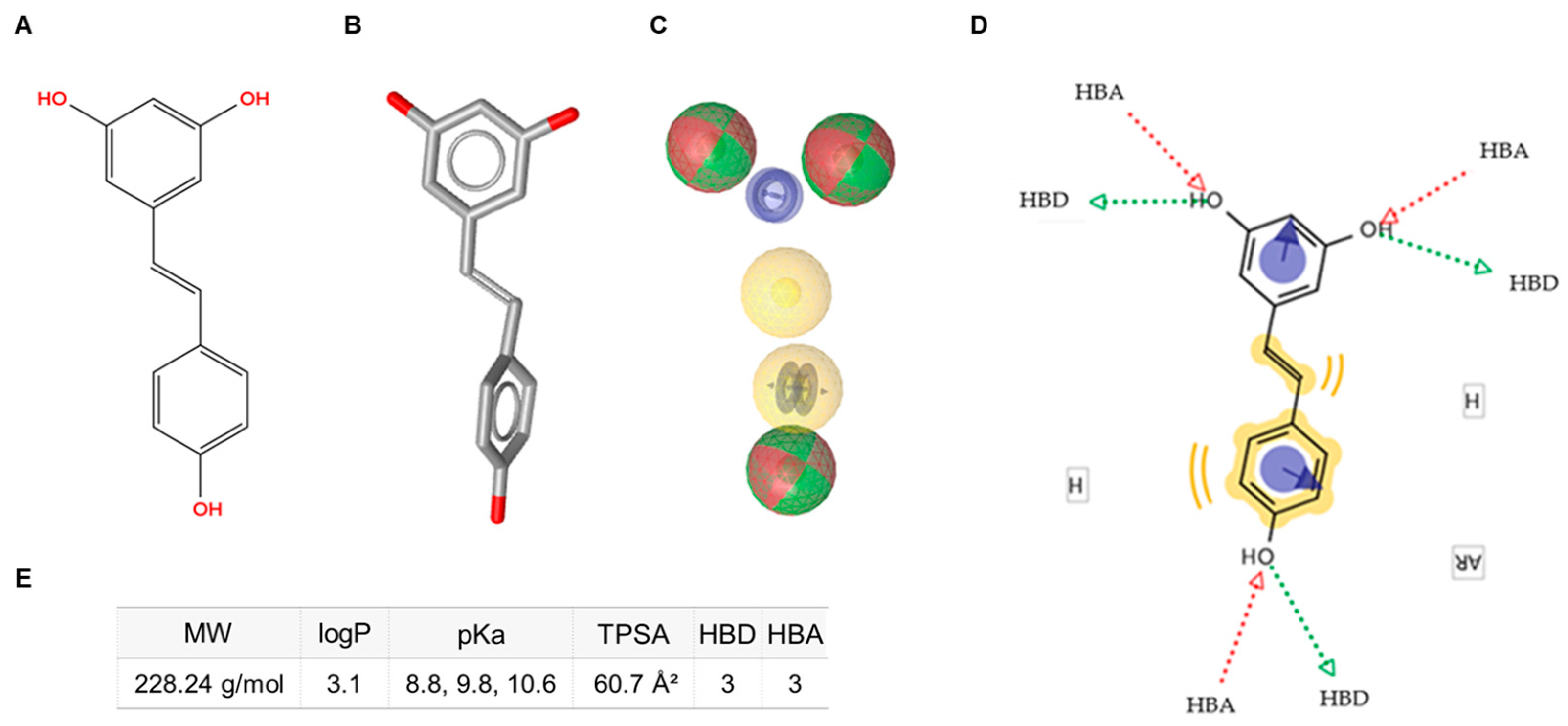
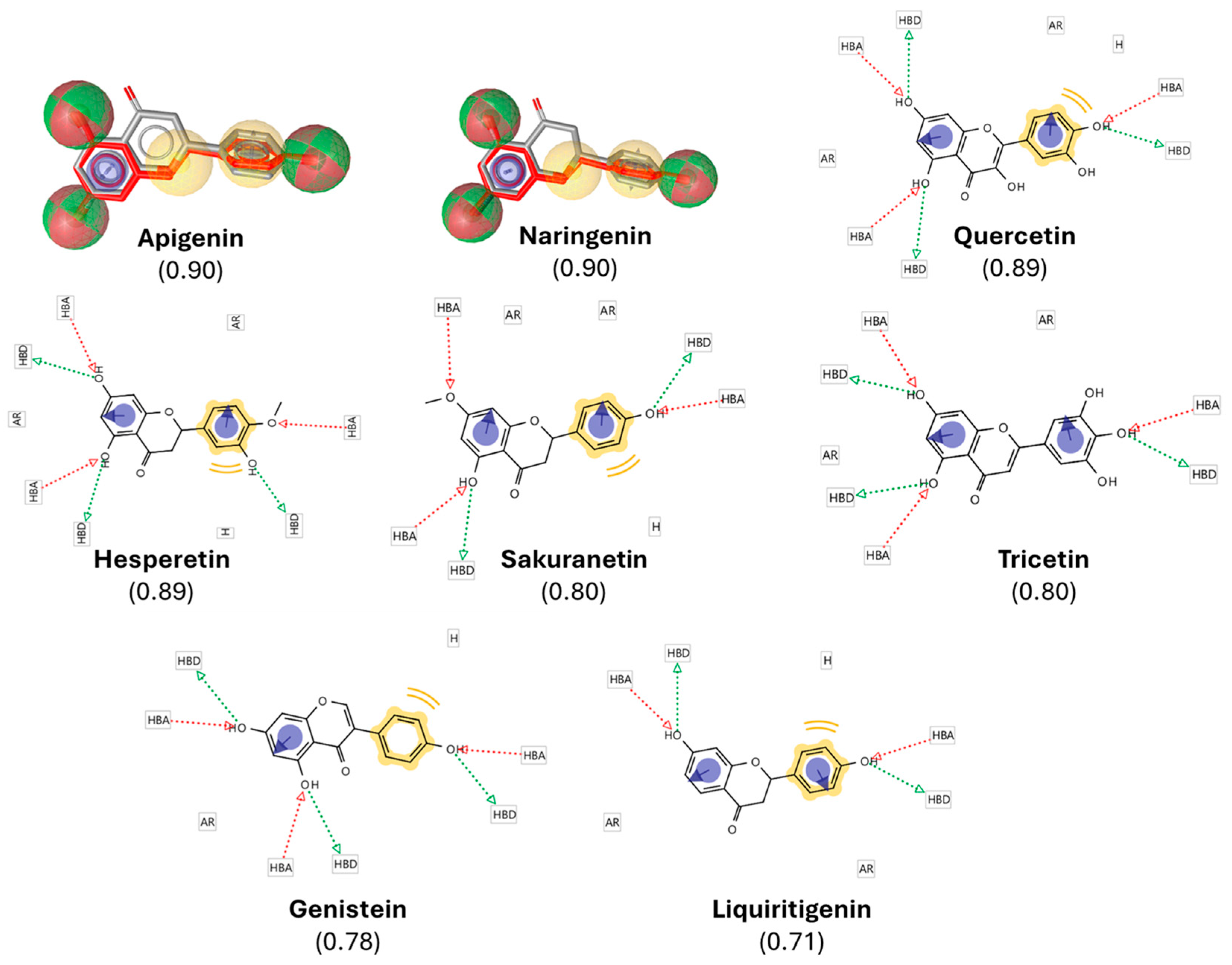
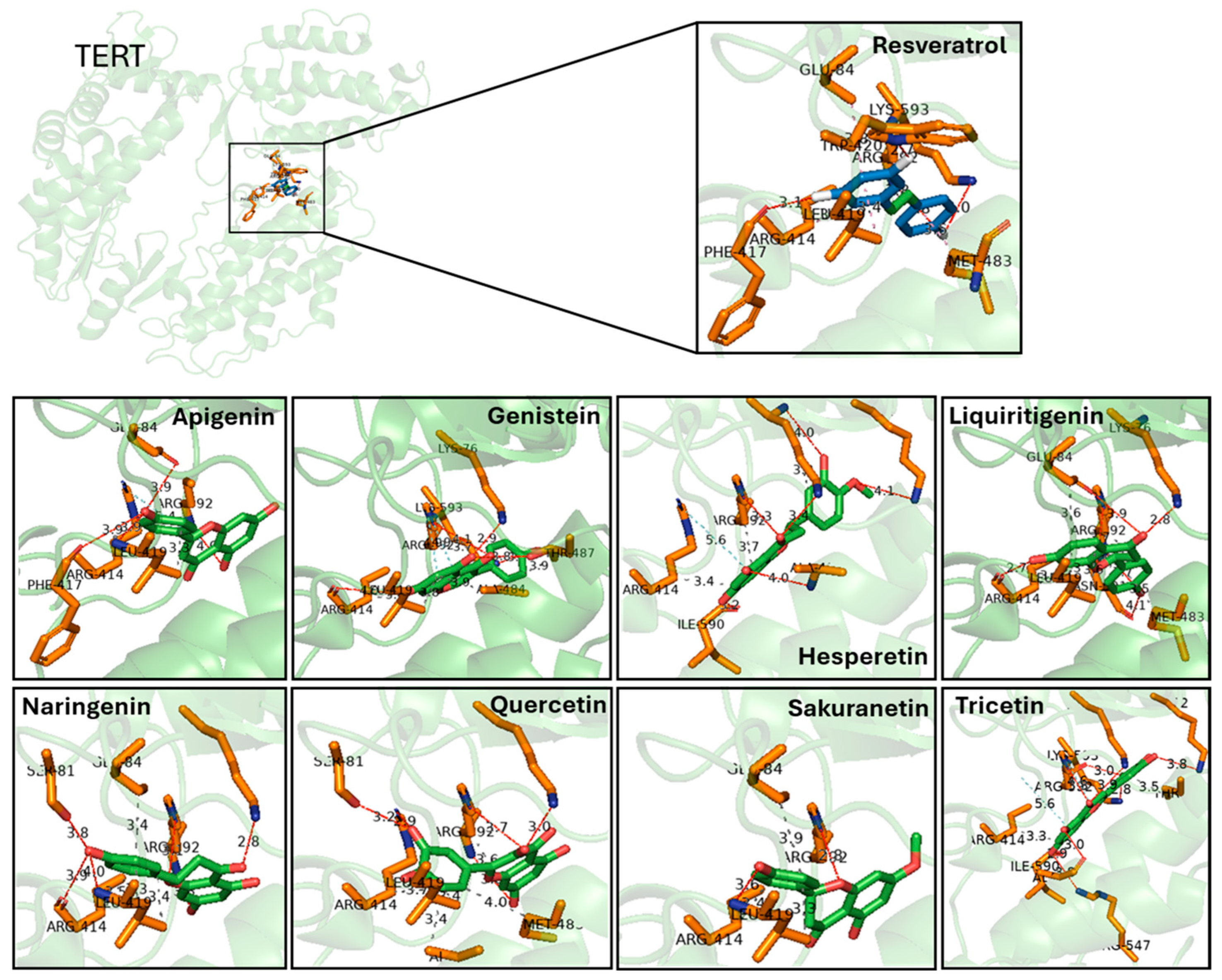

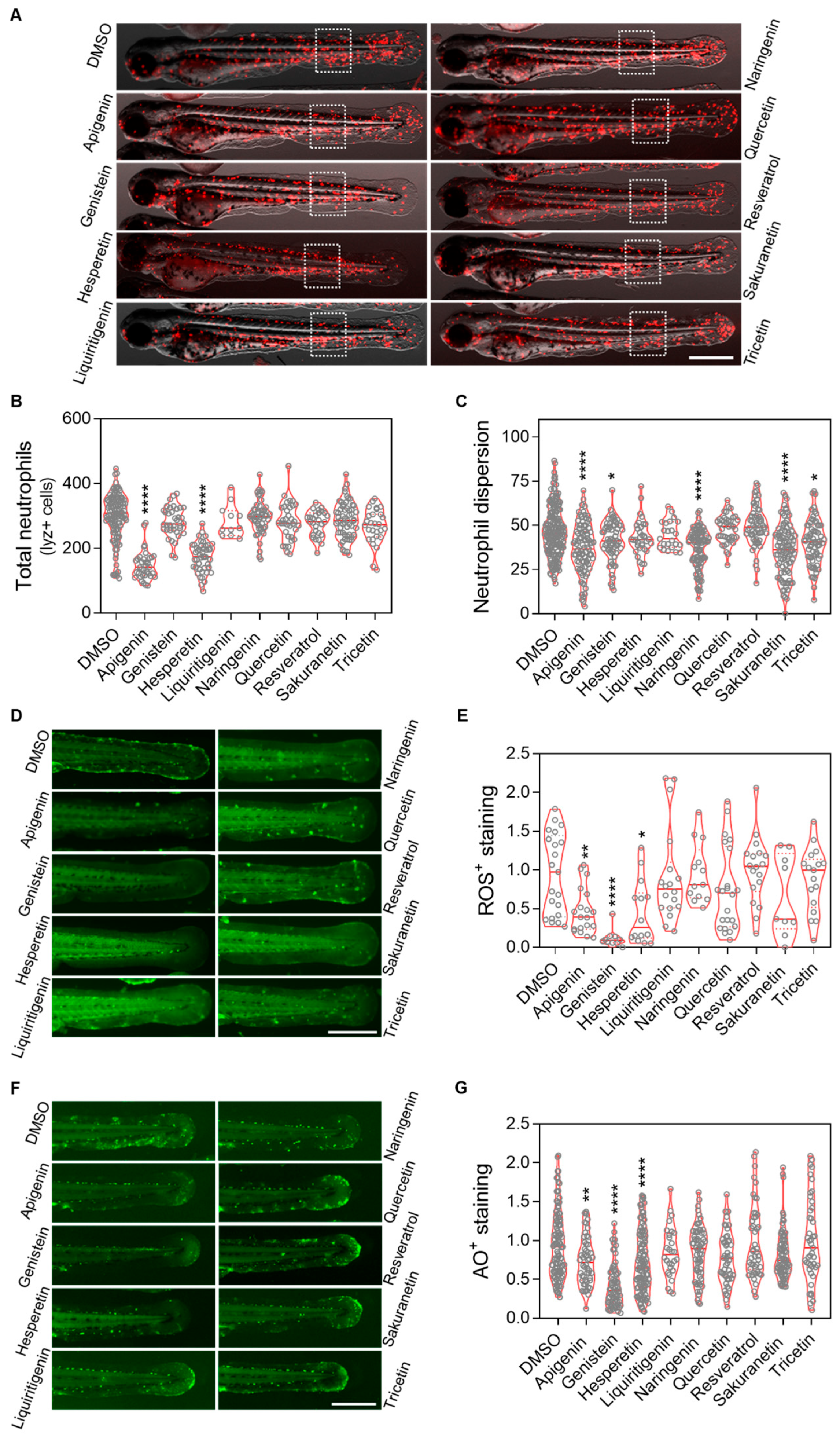
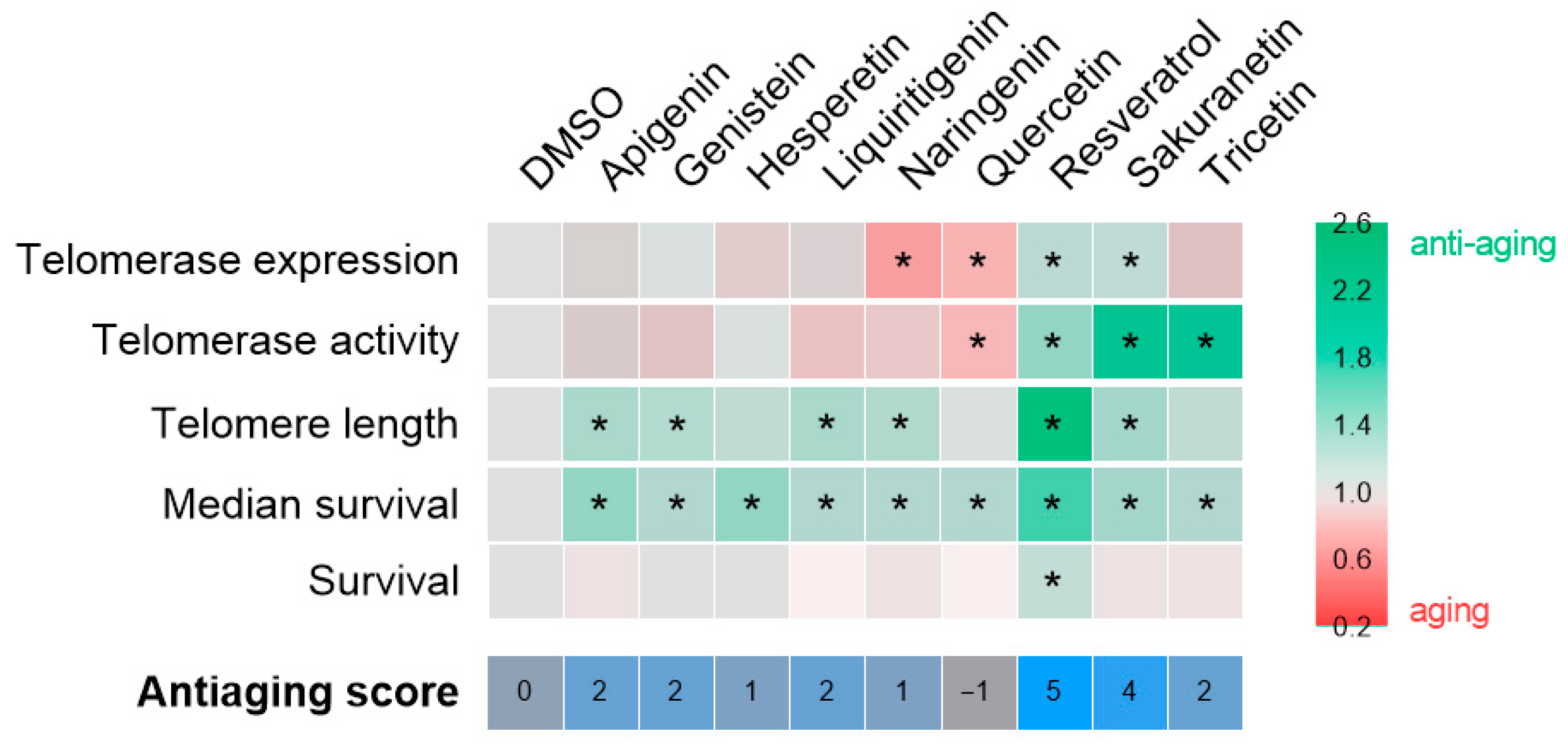
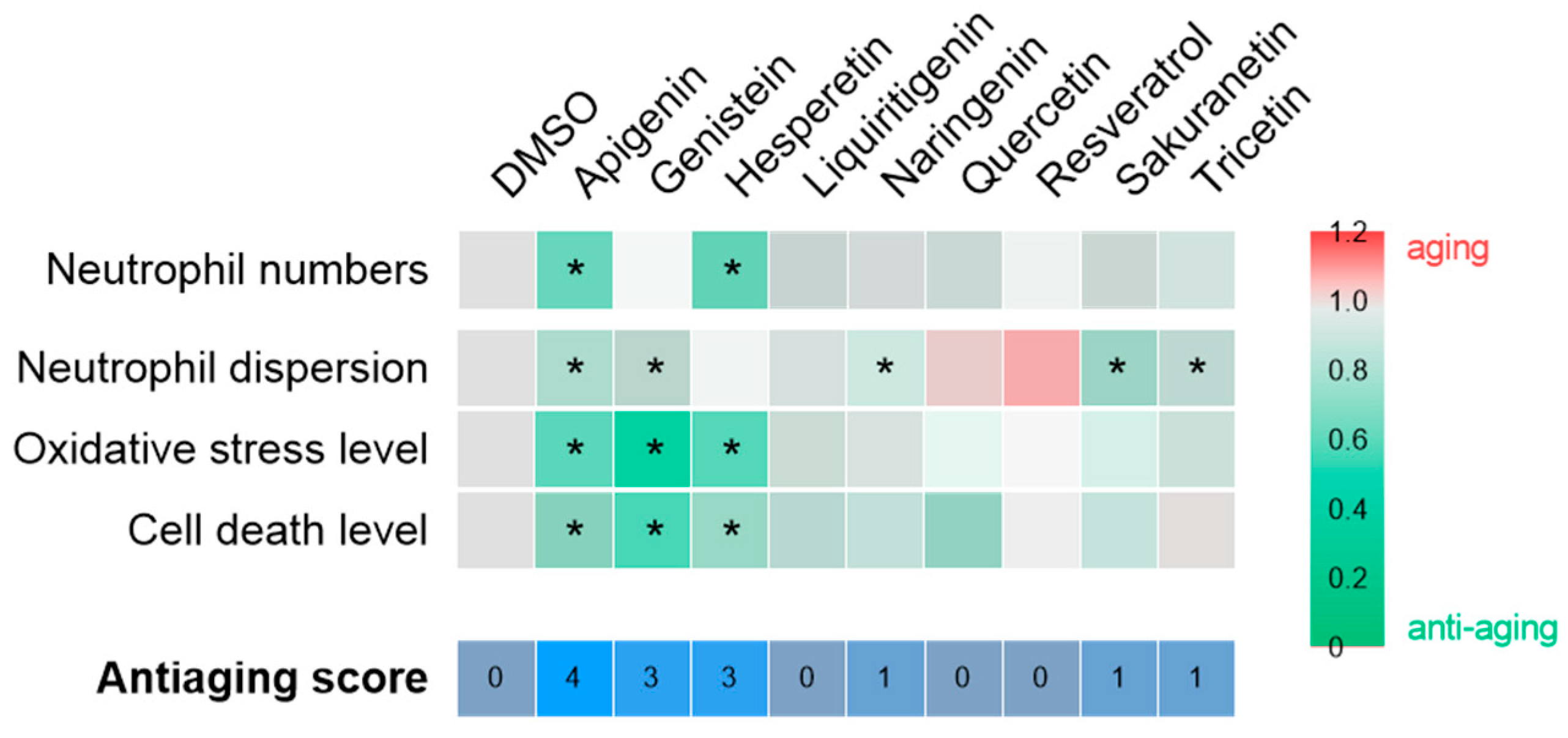
Disclaimer/Publisher’s Note: The statements, opinions and data contained in all publications are solely those of the individual author(s) and contributor(s) and not of MDPI and/or the editor(s). MDPI and/or the editor(s) disclaim responsibility for any injury to people or property resulting from any ideas, methods, instructions or products referred to in the content. |
© 2025 by the authors. Licensee MDPI, Basel, Switzerland. This article is an open access article distributed under the terms and conditions of the Creative Commons Attribution (CC BY) license (https://creativecommons.org/licenses/by/4.0/).
Share and Cite
Hernández-Silva, D.; Cabello, C.; Cayuela, M.L.; Pérez-Sánchez, H.; Alcaraz-Pérez, F. Synergizing Virtual Screening and Zebrafish Models to Identify Resveratrol-Derived Antiaging Polyphenols. Pharmaceuticals 2025, 18, 1630. https://doi.org/10.3390/ph18111630
Hernández-Silva D, Cabello C, Cayuela ML, Pérez-Sánchez H, Alcaraz-Pérez F. Synergizing Virtual Screening and Zebrafish Models to Identify Resveratrol-Derived Antiaging Polyphenols. Pharmaceuticals. 2025; 18(11):1630. https://doi.org/10.3390/ph18111630
Chicago/Turabian StyleHernández-Silva, David, Cynthia Cabello, María Luisa Cayuela, Horacio Pérez-Sánchez, and Francisca Alcaraz-Pérez. 2025. "Synergizing Virtual Screening and Zebrafish Models to Identify Resveratrol-Derived Antiaging Polyphenols" Pharmaceuticals 18, no. 11: 1630. https://doi.org/10.3390/ph18111630
APA StyleHernández-Silva, D., Cabello, C., Cayuela, M. L., Pérez-Sánchez, H., & Alcaraz-Pérez, F. (2025). Synergizing Virtual Screening and Zebrafish Models to Identify Resveratrol-Derived Antiaging Polyphenols. Pharmaceuticals, 18(11), 1630. https://doi.org/10.3390/ph18111630






